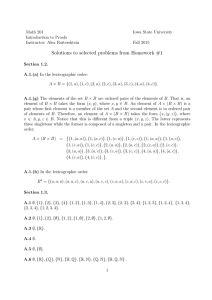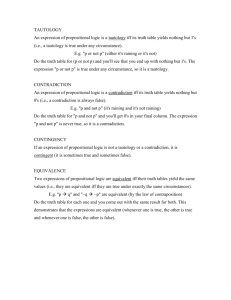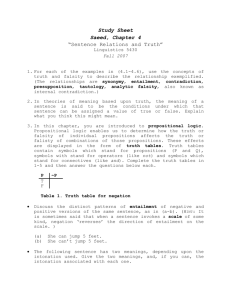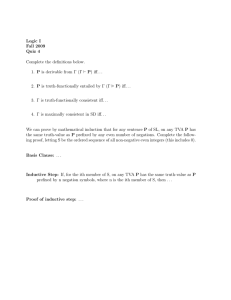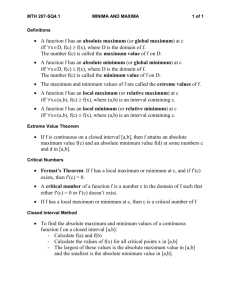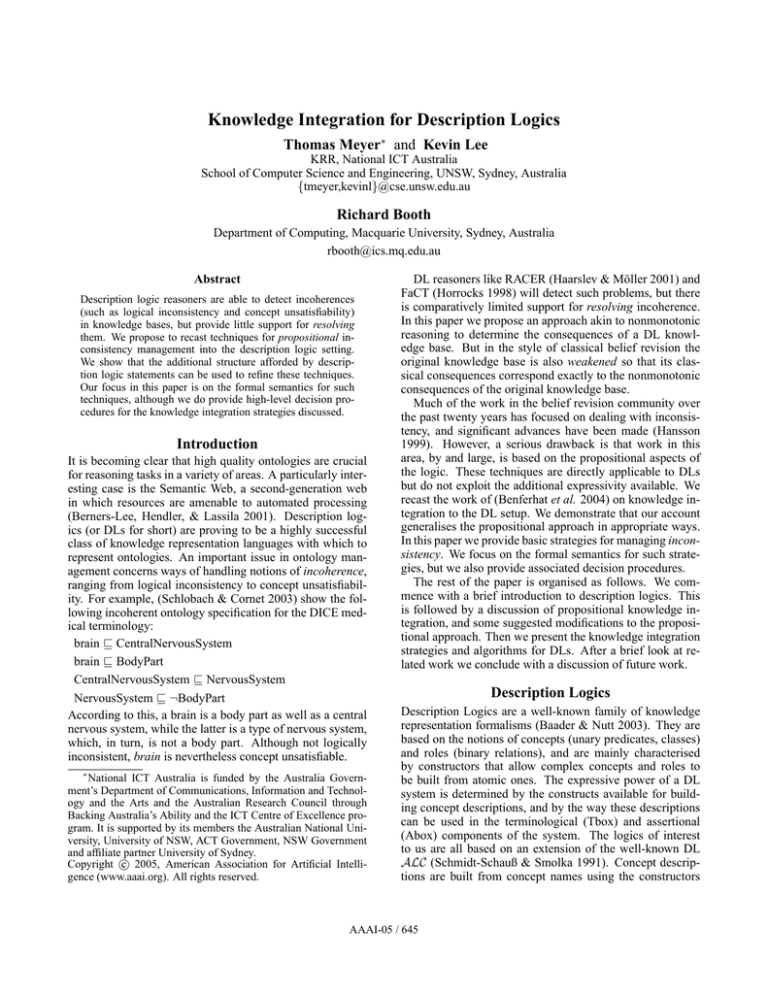
Knowledge Integration for Description Logics
Thomas Meyer∗ and Kevin Lee
KRR, National ICT Australia
School of Computer Science and Engineering, UNSW, Sydney, Australia
{tmeyer,kevinl}@cse.unsw.edu.au
Richard Booth
Department of Computing, Macquarie University, Sydney, Australia
rbooth@ics.mq.edu.au
Abstract
Description logic reasoners are able to detect incoherences
(such as logical inconsistency and concept unsatisfiability)
in knowledge bases, but provide little support for resolving
them. We propose to recast techniques for propositional inconsistency management into the description logic setting.
We show that the additional structure afforded by description logic statements can be used to refine these techniques.
Our focus in this paper is on the formal semantics for such
techniques, although we do provide high-level decision procedures for the knowledge integration strategies discussed.
Introduction
It is becoming clear that high quality ontologies are crucial
for reasoning tasks in a variety of areas. A particularly interesting case is the Semantic Web, a second-generation web
in which resources are amenable to automated processing
(Berners-Lee, Hendler, & Lassila 2001). Description logics (or DLs for short) are proving to be a highly successful
class of knowledge representation languages with which to
represent ontologies. An important issue in ontology management concerns ways of handling notions of incoherence,
ranging from logical inconsistency to concept unsatisfiability. For example, (Schlobach & Cornet 2003) show the following incoherent ontology specification for the DICE medical terminology:
brain v CentralNervousSystem
brain v BodyPart
CentralNervousSystem v NervousSystem
NervousSystem v ¬BodyPart
According to this, a brain is a body part as well as a central
nervous system, while the latter is a type of nervous system,
which, in turn, is not a body part. Although not logically
inconsistent, brain is nevertheless concept unsatisfiable.
∗
National ICT Australia is funded by the Australia Government’s Department of Communications, Information and Technology and the Arts and the Australian Research Council through
Backing Australia’s Ability and the ICT Centre of Excellence program. It is supported by its members the Australian National University, University of NSW, ACT Government, NSW Government
and affiliate partner University of Sydney.
c 2005, American Association for Artificial IntelliCopyright gence (www.aaai.org). All rights reserved.
DL reasoners like RACER (Haarslev & Möller 2001) and
FaCT (Horrocks 1998) will detect such problems, but there
is comparatively limited support for resolving incoherence.
In this paper we propose an approach akin to nonmonotonic
reasoning to determine the consequences of a DL knowledge base. But in the style of classical belief revision the
original knowledge base is also weakened so that its classical consequences correspond exactly to the nonmonotonic
consequences of the original knowledge base.
Much of the work in the belief revision community over
the past twenty years has focused on dealing with inconsistency, and significant advances have been made (Hansson
1999). However, a serious drawback is that work in this
area, by and large, is based on the propositional aspects of
the logic. These techniques are directly applicable to DLs
but do not exploit the additional expressivity available. We
recast the work of (Benferhat et al. 2004) on knowledge integration to the DL setup. We demonstrate that our account
generalises the propositional approach in appropriate ways.
In this paper we provide basic strategies for managing inconsistency. We focus on the formal semantics for such strategies, but we also provide associated decision procedures.
The rest of the paper is organised as follows. We commence with a brief introduction to description logics. This
is followed by a discussion of propositional knowledge integration, and some suggested modifications to the propositional approach. Then we present the knowledge integration
strategies and algorithms for DLs. After a brief look at related work we conclude with a discussion of future work.
Description Logics
Description Logics are a well-known family of knowledge
representation formalisms (Baader & Nutt 2003). They are
based on the notions of concepts (unary predicates, classes)
and roles (binary relations), and are mainly characterised
by constructors that allow complex concepts and roles to
be built from atomic ones. The expressive power of a DL
system is determined by the constructs available for building concept descriptions, and by the way these descriptions
can be used in the terminological (Tbox) and assertional
(Abox) components of the system. The logics of interest
to us are all based on an extension of the well-known DL
ALC (Schmidt-Schauß & Smolka 1991). Concept descriptions are built from concept names using the constructors
AAAI-05 / 645
disjunction (C t D), conjunction (C u D), negation (¬C),
existential restriction (∃R.C) and value restriction (∀R.C),
where C, D stand for concepts and R for a role name. To
define the semantics of concept descriptions, concepts are
interpreted as subsets of a domain of interest, and roles as
binary relations over this domain. An interpretation I consists of a non-empty set ∆I (the domain of I) and a function
·I (the interpretation function of I) which maps every concept name A to a subset AI of ∆I , and every role name R to
a subset RI of ∆I × ∆I . The interpretation function is extended to arbitrary concept descriptions as follows. Let C, D
be concept descriptions and R a role name, and assume that
C I and DI are already defined. Then (¬C)I = ∆I \ C I ,
(C t D)I = C I ∪ DI , (C u D)I = C I ∩ DI ,
(∃R.C)I = {x | ∃y s.t. (x, y) ∈ RI and y ∈ C I },
(∀R.C)I = {x | ∀y, (x, y) ∈ RI implies y ∈ C I }.
A DL knowledge base consists of two finite and mutually
disjoint sets. A Tbox which introduces the terminology, and
an Abox which contains facts about particular objects in the
application domain. Tbox statements have the form C v D
(inclusions) and C =D
˙ (equalities) where C and D are (possibly complex) concept descriptions. The semantics of Tbox
statements is as follows: an interpretation I satisfies C v D
iff C I ⊆ DI , I satisfies C =D
˙ iff C I = DI . Objects in
the Abox are referred to by a finite number of individual
names and these names may be used in two types of assertional statements: concept assertions of the type C(a) and
role assertions of the type R(a, b), where C is a concept description, R is a role name, and a and b are individual names.
To provide a semantics for Abox statements it is necessary to
add to every interpretation an injective denotation function d
which satisfies the unique names assumption: it maps every
individual name a to a different element aI of the domain
∆I (we define d separately from the interpretation function
to facilitate the definition of a pre-interpretation later in the
paper). An interpretation I satisfies the assertion C(a) iff
aI ∈ C I , and it satisfies R(a, b) iff (aI , bI ) ∈ RI . I is a
model of a DL (Tbox or Abox) statement φ iff it satisfies the
statement, and is a model of a DL knowledge base B iff it
satisfies every statement in B. The models of a statement
φ (or knowledge base B) are denoted by M (φ) (or M (B)).
Because any equality C =D
˙ is equivalent to the set of inclusions {C v D, D v C} we take a Tbox to contain only
inclusions. A DL knowledge base B entails a DL statement
φ, written as B φ, iff every model of B is a model of φ.
Propositional knowledge integration
Propositional knowledge integration, as described in (Benferhat et al. 2004), takes as input a stratified knowledge
base K = (S1 , . . . , Sn ) where, for i ∈ {1, . . . , n}, Si is
a knowledge base, or finite set of propositional sentences
(of a finitely generated propositional logic). Sentences in
a stratum Si are all judged to be of equal reliability, while
sentences contained in a higher stratum, i.e. in an Sj for
j > i, are seen as less reliable. In (Benferhat et al. 2004)
the strategies proposed to minimise the loss of information that occurs when a stratified knowledge base is in-
consistent are shown to yield identical results to the lexicographic system for knowledge integration (Benferhat et
al. 1993). It is well-known that lexicographic entailment
is a versatile system with desirable theoretical properties.
For example, it has been shown in (Benferhat et al. 1998;
Nebel 1998) that it can be used to model all classical AGM
belief revision operators. We provide here an alternative
semantic characterisation of lexicographic entailment based
on the notion of exceptions. The advantage of this characterisation is that it makes a clear distinction between the following two distinct principles at work:
(Independence) Sentences in a stratum are assumed to
have been obtained independently
(Precedence) More reliable information should take complete precedence over less reliable information
Independence is used implicitly in the work of (Benferhat et
al. 2004). It is applied to sentences in each stratum Si to obtain the preference ordering over the set V of propositional
valuations associated with Si and is formalised in terms of
exceptions. The number of Si -exceptions relative to valuation v is the number of sentences in Si false in v; the fewer
Si -exceptions, the more preferred v will be.
Definition 1 The number of φ-exceptions eφ (v) for a valuation v is 0 if v ∈ M (φ) and 1 otherwise. For a finite set of
sentences X,Pthe number of X-exceptions for a valuation v
is eX (v) = φ∈X eφ (v). The ordering X on V is defined
as: v X w iff eX (v) ≤ eX (w).
It is only after the Independence principle has been applied
to all strata that the Precedence principle is applied to the
orderings associated with the different strata to obtain a lexicographically combined preference ordering.
Definition 2 Let K = (S1 , . . . , Sn ) be a stratified knowledge base and for i ∈ {1, . . . , n}, let Si be a total preorder on V . Then v lex w iff ∀j ∈ {1, . . . , n}, [v Sj w
or v ≺Si w for some i < j].
Definition 2 constructs lex by starting with S1 and keeps
on refining it with strata orderings of lower preference. We
use lex to define lexicographic entailment:
Definition 3 A stratified knowledge base K lexicographically entails φ, written K lex φ, iff the (lex )-minimal
models satisfy φ.
The view of lexicographic entailment as an application of
Independence and Precedence is also present in a new strategy for knowledge integration, conjunctive maxi-adjustment
or CMA, that we propose in Algorithm 1. The idea is to
work through K stratum by stratum in order of decreasing
precedence, and to construct a consistent knowledge base
B, adding as many sentences as possible while maintaining consistency, and weakening those strata responsible for
inconsistencies. In this sense it is similar to whole disjunctive maxi-adjustment (Benferhat et al. 2004), but the way in
which strata are weakened is (syntactically) different. With
CMA, if Si is inconsistent with the part of B constructed
so far, it is replaced by the disjunction of the cardinalitymaximal conjunctions of Si -formulas consistent with B.
The following example is a simple demonstration of CMA.
AAAI-05 / 646
Algorithm 1 Conjunctive maxi-adjustment (CMA)
Input: K = (S1 , . . . , Sn )
Output: A consistent knowledge base
B := ∅
for i := 1 to n do
j := |Si |
repeat W
V
φ := of all s of size j of formulas of Si
j := j − 1
until B ∪ {φ} is consistent or j = 0
if B ∪ {φ} is consistent then
B := B ∪ {φ}
end if
end for
return B
propositional CMA makes use of disjunctions of conjunctions of sentences. But DL languages do not allow disjunctions of Tbox sentences with Abox sentences, and an expression such as (C v D) t D(a) is thus ill-formed. To deal
with this issue we introduce the notion of a disjunctive DL
knowledge base, or DKB, as a set of DL knowledge bases.
The semantics of DKBs is defined as follows.
Definition 4 A DKB B is satisfied by an interpretation I (I
is a model of B) iff I is a model of at least one of the elements
of B. B entails a DKB Φ (B Φ) iff every model of B is a
model of Φ.
Example 1 Let K = (S1 , S2 ), S1 = {¬(p ∧ q), ¬(q ∧ r),
¬(p ∧ r)} and S2 = {p, q, r}. S1 is consistent, so B is set
to S1 . S2 is inconsistent with B, so φ is set to (p ∧ q)∨(p ∧
r)∨(q∧r). φ is inconsistent with B, so the latter is weakened
further by setting it to p ∨ q ∨ r. Now φ is consistent with B
so B is set to {¬(p ∧ q), ¬(q ∧ r), ¬(p ∧ r), p ∨ q ∨ r}.
It is easily verified that Algorithm 1 always terminates. Furthermore, it produces results that are equivalent to lexicographic entailment, and therefore also to the strategies discussed in (Benferhat et al. 2004).
Proposition 1 Let K be a stratified knowledge base and B
the knowledge base obtained from K by Algorithm 1. Then
K lex φ iff B φ.
The principal reason for the introduction of CMA is that the
two algorithms for knowledge integration described in the
next section are natural extensions of it.
For the rest of the paper we modify our definition of a
stratified knowledge base so that each stratum is a multiset of sentences, denoted by square brackets (so a stratum
has the form [φ1 , . . . , φn ]). This allows us to prove a result
which does not hold if strata are represented as sets.
Proposition 2 For K = (S1 , . . . , Sn ), K 0 = (S10 , . . . , Sn0 )
and every i ∈ {1, . . . , n}, let there be a bijection fi between
Si and Si0 s.t. fi (φ) ≡ φ. Then K lex ψ iff K 0 lex ψ.
Knowledge integration for description logics
In this section we recast the techniques of propositional
knowledge integration to DLs, with the input being a stratified DL knowledge base K = (S1 , . . . , Sn ) where, for
i ∈ {1, . . . , n}, Si is a finite multi-set of DL sentences. We
present versions of lexicographic entailment and the CMA
strategy for DL knowledge integration obtained from a direct conversion of the techniques used in the propositional
case. We argue that these versions do not exploit the expressivity of DLs adequately, and refine both lexicographic entailment and CMA. We show that the refined versions of lexicographic entailment and CMA produce identical results.
But before doing so we need to deal with a number of
technical issues. The first one concerns the CMA strategy
and the level of expressivity in DL languages. Recall that
Informally B can be read as the disjunction of its elements,
with a single element of B viewed as the conjunction of the
sentences contained in it. For example, {[C v D, C(a)],
[C v D, D(a)]} states that both C v D and C(a) hold, or
that both C v D and D(a) hold. There are more fundamental reasons for the use of DKBs as well, which will briefly
be touched on in the conclusion.
The next issue to consider is the comparability of DL interpretations. The semantics of propositional lexicographic
entailment makes use of the fact that all propositional valuations are “possible worlds” that can all be compared with
respect to preference. But the additional structure of DL interpretations makes it impossible to maintain this comparability in the semantics. In particular, whenever two interpretations have different domains or do not map the same individual names to the same elements in the domain, it is counterintuitive to insist that they be comparable in terms of preference. This issue is solved by requiring that only interpretations obtained from the same pre-interpretation be comparable. A pre-interpretation is an ordered pair π = (∆π , dπ ),
where ∆π is a domain and dπ is a denotation function. Let
Π be the class of all pre-interpretations. For every preinterpretation π = (∆π , dπ ), let I π be the class of interpretations I with ∆I = ∆π and dI = dπ . We provide a
semantics similar to that of propositional lexicographic entailment. But each ordering Si on valuations associated
with a stratum Si will, in the case of DLs, be replaced by a
class of orderings πSi : one for each pre-interpretation π in
Π. For a fixed π, the orderings πSi for i ∈ {1, . . . , n} are
then lexicographically combined using Definition 2 to obtain
the ordering πlex . Lexicographic entailment is then defined
in terms of the minimal models of all these orderings. That
is, given a preference ordering πlex for each π ∈ Π, lexicographic entailment for stratified DL knowledge bases is
defined as follows:
S
(lex ) K lex Φ iff π∈Π minπlex ⊆ M (Φ)
where minπlex refers to the (πlex )-minimal models. The
one remaining question is how the preference orderings πSi
used in the construction of πlex should be obtained. A first
attempt is to use the same technique as that used for propositional lexicographic entailment. That is, for each I ∈ I π
and each stratum Si , let the number of Si -exceptions w.r.t.
I be the number of sentences in Si falsified by I, and use
these exceptions to generate the ordering πSi .
Definition 5 Let π ∈ Π, I ∈ I π , φ a DL statement, and X
a multi-set of DL statements. The number of φ-exceptions
AAAI-05 / 647
eφ (I) for I is 0 if I satisfies φ and P
1 otherwise. The number
of X-exceptions for I is: eX (I) = φ∈X eφ (I). The ordering πX on I π is defined as: I πX J iff eX (I) ≤ eX (J).
The DL version of CMA is presented in Algorithm 2. It is a
compilation of DL lexicographic entailment.
Algorithm 2 CMA for DLs (CMA-DL)
Input: K = (S1 , . . . , Sn )
Output: A consistent DKB
B := {∅}
for i := 1 to n do
C := B
for all B ∈ C do
j := |Si |
repeat
X := {X | X ⊆ Si and |X| = j}
j := j − 1
until B ∪ X is consistent for some X ∈ X
B := (B \ {B}) ∪
{B ∪ X | (X ∈ X ) &(B ∪ X) is consistent}
end for
end for
return B
Proposition 3 Let K be a stratified DL knowledge base, B
the DKB obtained from K by CMA-DL in Algorithm 2, let
lexicographic entailment for DLs be defined in terms of Definition 5, and let Φ be a DKB. Then K lex Φ iff B Φ.
To see that Algorithm 2 always terminates, note that elements of C are always consistent by construction. If j is
ever set to 0 in the repeat loop, X will be set to {∅}, and
then B ∪ X has to be consistent, since B ∈ C. The following example demonstrates how Algorithm 2 works.
Example 2 Let K = (S1 , S2 ), S1 = [C v ¬D, C v ¬E,
D v ¬E] and S2 = [C(a), D(a), E(a)]. S1 is consistent,
so B (and C) is set to {S1 }. Now B is set to the only element
of C: [C v ¬D, C v ¬E, D v ¬E]. S2 is inconsistent
with B so, during the second iteration of the repeat loop, X
is set to {[C(a), D(a)], [C(a), E(a)], [D(a), E(a)]}. Every
element of X is inconsistent with B, and the next iteration of
the repeat loop sets X to {[C(a)], [D(a)], E(a)]}. Now all
elements of X are consistent with B, so B is removed from
B and replaced with three multi-sets, yielding:
B = {[C v ¬D, C v ¬E, D v ¬E, C(a)],
[C v ¬D, C v ¬E, D v ¬E, D(a)],
[C v ¬D, C v ¬E, D v ¬E, E(a)]}.
Thus B states that the three statements C v ¬D, C v ¬E,
and D v ¬E hold, and that, in addition, at least one of
C(a), D(a) or E(a) holds. A consequence of all these statements is that exactly one of C(a), D(a) or E(a) holds.
Lexicographic entailment for DLs and the CMA-DL strategy are both faithful translations of their propositional counterparts. It is precisely because of this that they do not take
the structure of DL statements into account. The following
example illustrates this deficiency.
Example 3 Let K = (S1 , S2 ), where S1 = [bird(tweety),
¬f lies(tweety), bird(chirpy)], and S2 = [bird v f lies].
S1 is consistent, and so B is set to {S1 }. S2 is inconsistent with S1 , the only element of B, and so B is returned as
{[bird(tweety), ¬f lies(tweety), bird(chirpy)]}.
When Algorithm 2 is applied to K from Example 3, it concludes, correctly, that Tweety is a non-flying bird and that
Chirpy is a bird. But it does not conclude that Chirpy flies
since it has discarded the statement bird v f lies. It therefore does not exploit the structure of bird v f lies appropriately. Ideally we should be able to conclude that Tweety is
an exception and that all birds other than Tweety (including
Chirpy) can fly. For this to be possible we need to weaken
Tbox statements such as bird v f lies, something that is not
possible in the propositional case. Semantically we effect
such a weakening by modifying the definition of exceptions
in Definition 5. For Abox statements the definition stays unchanged, but for Tbox statements the number of exceptions
will be the number of elements in the domain violating the
statement. An element in the domain of an interpretation I
violates a statement of the form C v D if it is in C I but not
in DI , i.e. if it is in C I ∩ (¬DI ).
Definition 6 Let π ∈ Π, I ∈ I π , φ a DL statement, and X
a multi-set of DL statements. If φ is an Abox statement, the
number of φ-exceptions eφ (I) for an interpretation I is 0 if
I satisfies φ and 1 otherwise. If φ is a Tbox statement of the
form C v D, the number of φ-exceptions for I is:
I
C ∩ (¬D)I if C I ∩ (¬D)I is finite,
φ
e (I) =
∞
otherwise.
P
The number of X-exceptions for I is eX (I) = φ∈X eφ (I).
The ordering πX on I π is: I πX J iff eX (I) ≤ eX (J).
So πX is a version of cardinality-based circumscription
(Liberatore & Schaerf 1995): the more exceptions, the less
preferred an interpretation, while interpretations with an infinite number of exceptions are all equally bad.
Using Definition 6 in our construction of lexicographic
entailment will ensure that we will be able to conclude,
in Example 3, that Chirpy can fly. However, we are still
not able to express the conclusion that all birds, except for
Tweety, can fly. The problem is that the notion of an exception is not expressible in a DL. We cannot state that all
birds, with the exception of one, can fly. It is necessary to
extend the level of expressivity of the DL languages we are
interested in. An appropriate extension, adding cardinality
restrictions on concepts, was proposed in (Baader, Buchheit,
& Hollander 1996). There, its introduction was motivated by
the use of DL systems for solving configuration tasks. These
restrictions are statements in the Tbox, allowing one to express restrictions on the number of elements a concept may
have: (≥ m C) and (≤ n C) respectively express that the
concept C has at least m elements and at most n elements.
For our purposes it is sufficient to consider cardinality restrictions of the form (≤ n C).
An interpretation
I is said to satisfy a restriction of the
form (≤ n C) iff C I ≤ n. The statement C v D is equivalent to stating that the concept C u ¬D is empty, i.e. that
(≤ 0 C u ¬D). This demonstrates that the Tbox statements
AAAI-05 / 648
we have considered thus far can all be expressed as cardinality restrictions. Therefore, a Tbox will from now on be
a finite multi-set of cardinality restrictions. An interpretation I is a model of such a Tbox iff it satisfies each of its
restrictions. Other semantic notions such as entailment are
extended in the obvious way. With the inclusion of cardinality restrictions we can now rephrase S2 in Example 3 as
{(≤ 0 birdu¬f lies)}. And, using Definition 6, K now lexicographically entails that Tweety is a non-flying bird, that
Chirpy is a flying bird, and that there is at most one nonflying bird, (1 ≤ bird u ¬f lies), which is a weakening of
S2 . So it follows that, barring Tweety, all birds can fly.
The next step is to refine the CMA-DL strategy to coincide with the modified version of lexicographic entailment for DLs. This strategy, referred to as refined CMADL, is described in Algorithm 3. The main difference between the two algorithms is in the construction of X . Abox
sentences are treated exactly as in Algorithm 2: the jA
weakening W j (B A ) of
the
Abox B of a DL knowledge
A
base B (where j ≤ B ), contains all those sub multisets of B A where j elements have been removed. That is,
W j (B A ) = {B A \ Y | Y ⊆ B A and |Y | = j}. So,
for B A = [C(a), D(a), E(a)], W 1 (B A ) = {[C(a), D(a)],
[C(a), E(a)], [D(a), E(a)]}. For a Tbox sentence τ of the
form (≤ n C), let W (τ ) = {(≤ (n + j) C) | j ≥ 0}.
That is W (τ ) is the set of all weakened versions of τ . Furthermore, for a Tbox sentence τ of the form (≤ n C) and
τ 0 ∈ W (τ ) of the form (≤ m C), we let wτ (τ 0 ) = m − n.
So wτ (τ 0 ) measures the extent to which τ 0 is a weakening of
τ . For j ≥ 0, the j-weakening W j (B T ) of the Tbox B T of a
DL knowledge base B contains all those weakened versions
of B T for which the sum of the extent of the weakening is j.
That
B T = [τ1 , . . . , τn ], W j (B T ) = {[τ10 , . . . , τn0 ] |
Pn is, for
τi 0
T
= [(≤ 0 C),
i=1 w (τi ) = j}. For example, for B
2
T
(≤ 0 D)], W (B ) = {[(≤ 0 C), (≤ 2 D)], [(≤ 1 C),
(≤ 1 D)], [(≤ 2 C), (≤ 0 D)]}. And for j ≥ 0, the jweakening W j (B) of a DL knowledge base B contains all
combinations of i-weakenings of B A and k-weakenings of
B T for which i and k add up to j. That is,
A ∈ W i (B A ), T ∈ W k (B T ),
A
.
W j (B) = A ∪ T i ≤ B , and j = i + k}
For example, if B = [(≤ 0 C), C(a), C(b)], then
[(≤ 1 C), C(a)] , [(≤ 1 C), C(b)] ,
W 2 (B) =
.
[(≤ 0 C)] , [(≤ 2 C), C(a), C(b)]
So W 2 (B) contains those weakenings of B in which exactly
two exceptions occur. The j-weakenings of DL knowledge
bases are used in the repeat loop of Algorithm 3 where X is
set to the j-weakening of Si . As required, RCMA-DL is a
compilation of lexicographic entailment using Definition 6.
Proposition 4 Let K be a stratified DL knowledge base, B
the DKB obtained from K by RCMA-DL in Algorithm 3,
let lexicographic entailment for DLs be defined in terms of
Definition 6, and let Φ be a DKB. Then K lex Φ iff B Φ.
The proof that Algorithm 3 terminates hinges on the fact that
weakenings of Tbox sentences allow for more exceptions,
and the fact that the maximum number of exceptions to cater
Algorithm 3 Refined CMA-DL (RCMA-DL)
Input: K = (S1 , . . . , Sn )
Output: A consistent DKB
B := {∅}
for i := 1 to n do
C := B
for all B ∈ C do
j := 0
repeat
X := W j (Si )
j := j + 1
until B ∪ X is consistent for some X ∈ X
B := (B \ {B}) ∪
{B ∪ X | (X ∈ X ) &(B ∪ X) is consistent}
end for
end for
return B
for is bounded by the number of individual names occurring
in K. The example below demonstrates Algorithm 3 (where
b, f , t and c abbreviate bird, f lies, tweety and chirpy).
Example 4 Let K = (S1 , S2 ), S1 = [b(t), b(c)], and S2 =
[¬f (t), ¬f (c), (≤ 0 b u ¬f )]. S1 is consistent so RCMA-DL
sets B (and C) to {S1 }. Now B is set to the only element
of C: [b(t), b(c)]. S2 is inconsistent with B, so X is set
to W 1 (S2 ) = {[¬f (t), ¬f (c), (≤ 1 b u ¬f )], [¬f (t), (≤
0 b u ¬f )], [¬f (c), (≤ 0 b u ¬f )]}. Every element of X is
inconsistent with B, and so X is set to W 2 (S2 ) = {[¬f (t),
¬f (c), (≤ 2 b u ¬f )], [¬f (t), (≤ 1 b u ¬f )], [¬f (c), (≤
1 b u ¬f )], [(≤ 0 b u ¬f )]}. Now all the elements of X
are consistent with B, resulting in a B containing B ∪ X
for every X in X . Combined, the four elements of the DKB
B show that exactly one of the following four cases hold:
a) Tweety and Chirpy are the only two non-flying birds; b)
Tweety is the only non-flying bird; c) Chirpy is the only nonflying bird; d) All birds fly, including Tweety and Chirpy.
Related work
One of the first attempts to deal with inconsistency in logicbased terminological systems can be found in (Nebel 1990),
where it is phrased as a belief revision problem. More recently the solution of (Schlobach & Cornet 2003) is to provide support for inconsistency by correcting it. They propose a non-standard reasoning system for debugging inconsistent terminologies. The idea is to provide an explanation
by pinpointing the source of the inconsistency, while correction is left to human experts. In contrast, the approach taken
in (Huang et al. 2005) assumes that ontology reparation will
be too difficult. They propose to tolerate inconsistency and
apply a non-classical form of inference to obtain meaningful results. Our approach is a hybrid of these. We employ
a version of lexicographic entailment to determine the consequences of an inconsistent DL knowledge base, but the
original knowledge base is also weakened so that its classical consequences correspond exactly to the nonmonotonic
consequences of the original knowledge base.
In (Quantz & Royer 1992) a technique is described for
AAAI-05 / 649
assigning a preference semantics for defaults in terminological logics which uses exceptions, and therefore has some
similarities to our work. They draw a distinction between
strict inclusions (Tbox statements of the form A v B) and
defaults which is interpreted as “soft” inclusions. In our
framework this distinction can be modelled with two strata
in which all strict inclusions occur in S1 and all soft inclusions in S2 . In this sense our framework is more expressive than theirs. More importantly, their formal semantics
is not cardinality-based, and therefore yields quite different
results from ours. And finally, unlike us, they do not provide
a weakening of the original knowledge base.
An altogether different approach is the explicit introduction of nonmonotonicity into DLs, usually some variant of
default logic. See (Baader, Küsters, & Wolter 2003) for an
overview. While it is difficult to draw direct comparisons
with our work, similar intuitions might be identified and exploited.
Conclusion
We have proposed knowledge integration strategies for DLs
based on techniques developed in the propositional case, and
provided corresponding algorithms with disjunctive knowledge bases (DKBs) as output. It can be shown that the elements of a DKB produced as the output of Algorithm 2 or
3 are always pairwise inconsistent (modulo logical equivalence), a property which is useful (i) when inconsistency
management is an iterative process and (ii) as part of support provision for ontology engineers. This forms the basis
of an argument that the structure of DKBs are important and
ought to be retained as outputs of our algorithms.
We have shown how the structure of DL languages can
be exploited to define basic knowledge integration strategies. Our focus was on the formal semantics of knowledge
integration strategies, although we also provided high-level
decision procedures. The next step is the development of
tableaux-based algorithms for implementing the strategies
outlined in the paper. Some initial results suggest that the
complexity of the integration strategies may be no worse
than consistency checking in the DL under consideration.
An obvious question to consider is whether any additional
structure, such as the specification of role hierarchies and
transitivity of roles, can be exploited further to modify the
knowledge integration strategies in appropriate ways. Such
additional structure might also be used to ameliorate other
problems. For example, DKBs can be exponential in size,
which will severely affect their use in practice. But it might
be possible to limit the size of strata in stratified KBs using
the structure of sentences contained in it. A simple example
is the use of principles such as specificity: if the sentences
bird v f lies (all birds fly) and penguin v ¬f lies (all penguins don’t fly) occur in the same stratum, an application
of specificity will ensure that penguin v ¬f lies is given
precedence over bird v f lies, provided that penguin v
bird takes precedence over both. Finally, the management
of other notions of incoherence, such as concept unsatisfiability, is currently the topic of further investigation.
References
Baader, F., and Nutt, W. 2003. Basic description logics. In
Baader, F.; Calvanese, D.; McGuinness, D.; Nardi, D.; and
Patel-Schneider, P., eds., The Description Logic Handbook.
Baader, F.; Buchheit, M.; and Hollander, B. 1996. Cardinality restrictions on concepts. Artificial Intelligence
88:195–213.
Baader, F.; Küsters, R.; and Wolter, F. 2003. Extensions to
description logics. In Baader, F.; Calvanese, D.; McGuinness, D.; Nardi, D.; and Patel-Schneider, P., eds., The Description Logic Handbook.
Benferhat, S.; Cayrol, C.; Dubois, D.; Lang, J.; and
Prade, H. 1993. Inconsistency management and prioritized
syntax-based entailment. In Bajcsy, R., ed., Proceedings of
IJCAI-93, 640–645.
Benferhat, S.; Dubois, D.; Lang, J.; Prade, H.; Saffioti, A.;
and Smets, P. 1998. A general approach for inconsistency
handling and merging information in prioritized knowledge
bases. In Proceedings of KR’98, 466–477.
Benferhat, S.; Kaci, S.; Le Berre, D.; and Williams, M.
2004. Weakening conflicting information for iterated revision and knowledge integration. Artificial Intelligence
153:339–371.
Berners-Lee, T.; Hendler, J.; and Lassila, O. 2001. The
semantic web. Scientific American 284(5):3443.
Haarslev, V., and Möller, R. 2001. Racer system description. In Goré, R.; Leitsch, A.; and Nipkow, T., eds., IJCAR
2001, LNAI 2100.
Hansson, S. O. 1999. A Textbook of Belief Dynamics.
Horrocks, I. 1998. The FaCT system. In de Swart, H., ed.,
Tableaux ’98, LNAI 1397, 307–312.
Huang, Z.; van Harmelen, F.; ten Teije, A.; Groot, P.; and
Visser, C. 2005. Reasoning with inconsistent ontologies:
Framework and prototype. URL: http://wasp.cs.
vu.nl/sekt/download/sekt341.pdf.
Liberatore, P., and Schaerf, M. 1995. Relating belief revision and circumscription. In Proceedings of IJCAI-95,
1557–1563.
Nebel, B. 1990. Reasoning and Revision in Hybrid Representation Systems. LNAI 422. Springer-Verlag.
Nebel, B. 1998. How hard is it to revise a belief base.
In Dubois, D., and Prade, H., eds., Belief Change, Handbook of Defeasible Reasoning and Uncertainty Management Systems. Kluwer. 77–145.
Quantz, J., and Royer, V. 1992. A preference semantics for
defaults in terminological logics. In Proceedings of KR’92,
294–305.
Schlobach, S., and Cornet, R. 2003. Non-standard reasoning services for the debugging of description logic terminologies. In Proceedings of IJCAI 2003, 355–360.
Schmidt-Schauß, M., and Smolka, G. 1991. Attributive
concept descriptions with complements. Artificial Intelligence 48:1–26.
AAAI-05 / 650

